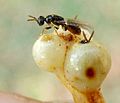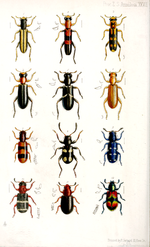Arthropod leg (redirect from Tarsomere)
tarsus which can be from three to seven segments, each referred to as a tarsomere. Except in species in which legs have been lost or become vestigial through...
26 KB (2,924 words) - 10:55, 12 December 2024
tarsus, with the tarsus in most instances being subdivided into five tarsomeres. At the tip of the limb is a pair of claws, and between these are cushion-like...
87 KB (9,307 words) - 17:41, 27 December 2024
A male Phalangium opilio, showing the long legs and the tarsomeres (the many small segments making up the end of each leg)...
63 KB (7,014 words) - 08:10, 16 December 2024
ventrally divergent, and mandibles have two or more teeth. All legs have five tarsomeres and the protibial spur is stout and curved. The metasoma has a syntergum...
2 KB (155 words) - 23:44, 18 January 2024
fore tarsomere is broadened slightly past the base, is parallel-sided, and is slightly narrower than the fore tibia. The remaining fore tarsomeres are...
4 KB (427 words) - 10:38, 5 January 2025
basal tarsomeres of the prolegs and midlegs being weakly dilated, and the protarsal claws being unequal and much shorter than the terminal tarsomere. In...
5 KB (574 words) - 09:54, 18 August 2023
last tarsomere of each leg is largely blackish, and sometimes the first and second tarsomeres have brown or black apices (in R. haraldi all tarsomeres are...
7 KB (728 words) - 23:00, 5 October 2024
forelegs and middle legs, only the first three tarsomeres have the ring of white scales, whereas tarsomere V on the hind legs is completely white. The femur...
78 KB (8,931 words) - 15:06, 8 December 2024
long basal piece is composed of three united tarsomeres, leaving the fourth and the fifth. The basal tarsomere is sometimes conspicuously enlarged and is...
129 KB (17,125 words) - 23:35, 5 December 2024
reveals five articulated tarsomeres and paired curved claws. Males and females have an adhesive setae covering the first three tarsomeres. The fourth is hidden...
67 KB (7,439 words) - 11:11, 23 December 2024
subfamilies Gonatocerinae and Mymarinae based on the number of segments (tarsomeres) in the tarsi. Both systems included further tribal categories. A fossil...
56 KB (5,611 words) - 00:53, 5 January 2025
parasternites II and III narrowed and nearly straight, and with the setae of the tarsomeres following the line of the tibial setae. Unlike giant water bugs in the...
9 KB (950 words) - 05:05, 27 May 2024
have three teeth. Notauli complete. In most genera, all legs have five tarsomeres, except for Odontofroggatia and Josephiella, which have four-segmented...
2 KB (193 words) - 22:20, 28 January 2024
(the first segment at most slightly longer than wide) and the fourth tarsomeres of the mid and hind legs being symmetrical. Polistes show sexual dimorphism...
56 KB (4,954 words) - 13:13, 2 November 2024
a liquid form which they then suck up. The tarsus has three segments (tarsomeres). at Mumbai Shield-backed bug (Graptocoris aulicus) nymph, Uganda Chrysocoris...
33 KB (2,834 words) - 11:59, 27 December 2024
postfemur/telofemur (=femur), patella (=tibia 1), tibia (tibia 2) and 2 tarsomeres (=tarsus and propodus) in origin. The leg segmentation of Paleozoic taxa...
69 KB (6,923 words) - 10:25, 4 January 2025
males and females the legs are short and sturdy, with an enlarged basal tarsomere on the front pair, containing the silk-producing glands; the mid and hind...
34 KB (4,007 words) - 01:53, 3 September 2024
the insect) that are divided into 2 segments, or tarsomeres; other genera in the tribe have 3 tarsomeres in each tarsus. There are about 15 or 16 species...
4 KB (317 words) - 07:39, 6 November 2024
II–IV with the tarsus having a specific pattern of three subsegments (tarsomeres). The Serikodiastida (Greek for "silk workers") share the ability to produce...
9 KB (703 words) - 19:56, 19 July 2024
marginal setae; Mandibles have three or four teeth; All legs have five tarsomeres. Diparidae consists of 11 genera: Cerodipara Chimaerolelaps Conodipara...
3 KB (269 words) - 22:00, 28 January 2024
southern Europe to Myanmar) has narrower light stripes and the first tarsomere on the foreleg is longer than the claw (almost equal in L. indicus). Kirkaldyia...
9 KB (1,112 words) - 16:18, 3 November 2024
and pad-like; it covers much of the mesopleural area. Legs have five tarsomeres; the protibial spur is stout and curved and a longitudinal basitarsal...
3 KB (293 words) - 20:25, 8 September 2024
are 5 tarsomeres (individual subsegments of the feet/tarsi). One or more of these subsegments on each leg is typically lobed, and the 4th tarsomere is normally...
39 KB (2,585 words) - 22:54, 3 April 2024
front tarsomere is subtriangular, truncate apically, about twice as wide as the apex of the tibia, and as long as wide. The second front tarsomere is nearly...
6 KB (667 words) - 15:50, 21 October 2024
metatibia black and yellow biannulate; metatarsus entirely black, basal tarsomere thick. A rather wide semi-circular area posterior of the lunula is non-pollinose...
3 KB (253 words) - 02:28, 27 October 2023
yellow, tarsomeres 4–5 black; metaleg with coxa black, trochanter yellow, femur and tibia black and yellow biannulate, tarsus black with tarsomeres 2 and...
4 KB (458 words) - 02:28, 27 October 2023
The first fore tarsomere is narrower than the end of the tibia and about 1.5 times longer than wide. The remaining fore tarsomeres are a little narrower...
9 KB (884 words) - 00:01, 22 December 2024
biannulate, with large rounded apicoventral dens; tarsus entirely black, basal tarsomere thick. The basal flagellomere is rectangular, the arista long and pilose...
3 KB (281 words) - 02:28, 27 October 2023
pointed apicoventral dens; metatarsus entirely black with thick basal tarsomere. The arista is long and pilose, about 2.5 times as long as the basal flagellomere...
3 KB (330 words) - 02:28, 27 October 2023
yellowish brown, shiny, trapezoid; pro- and mesoleg yellowish; protarsus and tarsomere 5 on mesotarsus brown; metaleg with coxa brownish, trochanter yellow,...
3 KB (330 words) - 02:28, 27 October 2023
























